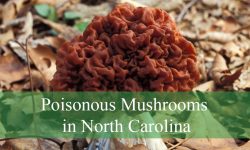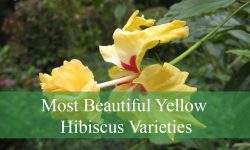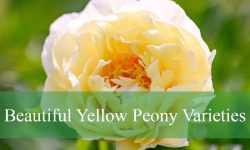Shrubs with red flowers bring vibrant energy and bold color to every landscape. These eye-catching plants create dramatic focal points, attract pollinators like hummingbirds, and add seasonal interest from spring through fall. With countless varieties available, it’s easy to find a red-flowering shrub that matches any climate or landscape design.
Tropical species like hibiscus and bougainvillea offer lush, exotic blooms, while cold-hardy options such as flowering quince and weigela provide reliable color in temperate regions. Each shrub comes with its own bloom shape, growth habit, and care requirements, offering a wide range of choices for borders, hedges, containers, or foundation plantings.
This guide features 23 stunning shrubs with red flowers, complete with pictures and identification details. From sun-drenched gardens in the Southwest to shaded corners in northern zones, there’s a red-flowering shrub suited to nearly every growing condition. Explore the list below to discover the perfect addition to your garden.
Different Types of Shrubs with Red Flowers
Knock Out Rose (Rosa ‘Radrazz’)
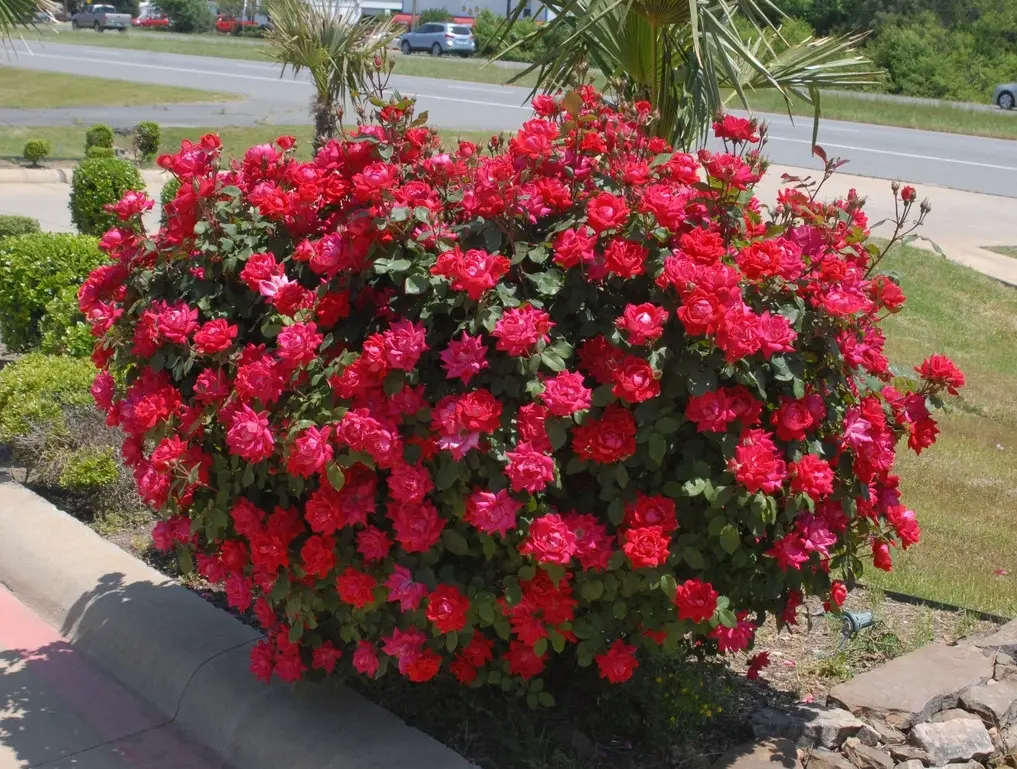
The Knock Out Rose is a modern shrub rose cultivar known for its exceptional disease resistance, especially to black spot, and its extended bloom time. This compact, bushy plant typically grows about 3 to 4 feet tall and wide, making it an ideal choice for foundation plantings, borders, or mass plantings. Its dense foliage and self-cleaning habit—meaning spent blooms fall off on their own—make it low-maintenance and highly desirable for busy gardeners.
This rose produces vibrant, cherry-red flowers that begin blooming in late spring and continue without pause until the first frost. The blooms are lightly fragrant and appear in clusters, standing out beautifully against the dark green, slightly glossy leaves. Because of its long blooming season and vivid coloration, the Knock Out® Rose adds continuous visual interest throughout the warmer months.
It thrives in USDA hardiness zones 5 through 11 and performs best in full sun, though it tolerates partial shade. For optimal growth, it prefers well-drained, slightly acidic soil and benefits from regular watering during dry spells. Pruning should be done in early spring to shape the plant and encourage new growth. Fertilizing once or twice during the growing season helps enhance bloom production.
Red Azalea (Rhododendron spp.)
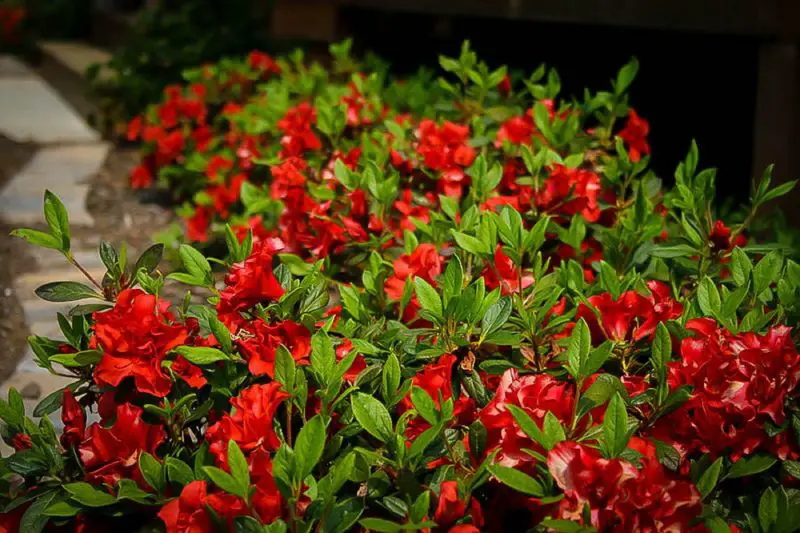
Red azaleas are a striking and diverse group of flowering shrubs that bring fiery color to the garden in spring. These deciduous or evergreen plants are usually compact, with a rounded form and densely packed, leathery leaves. Popular in woodland gardens or shaded borders, red azaleas add dramatic color with their abundant, trumpet-shaped blossoms.
Blooming typically occurs in mid to late spring, depending on the variety and region. The flowers vary in shades of red, from deep crimson to scarlet, and often blanket the entire shrub when in full bloom. The intense floral display lasts for several weeks, attracting pollinators like bees and butterflies while enhancing the visual appeal of the landscape.
Red azaleas grow well in USDA zones 5 to 9 and prefer partial shade, especially in areas with hot summers. They thrive in acidic, well-draining soil that is rich in organic matter. Regular mulching helps retain soil moisture and keeps roots cool. Water deeply during dry periods, and avoid pruning too late in the season, as azaleas form flower buds on old wood.
Weigela ‘Red Prince’ (Weigela florida)
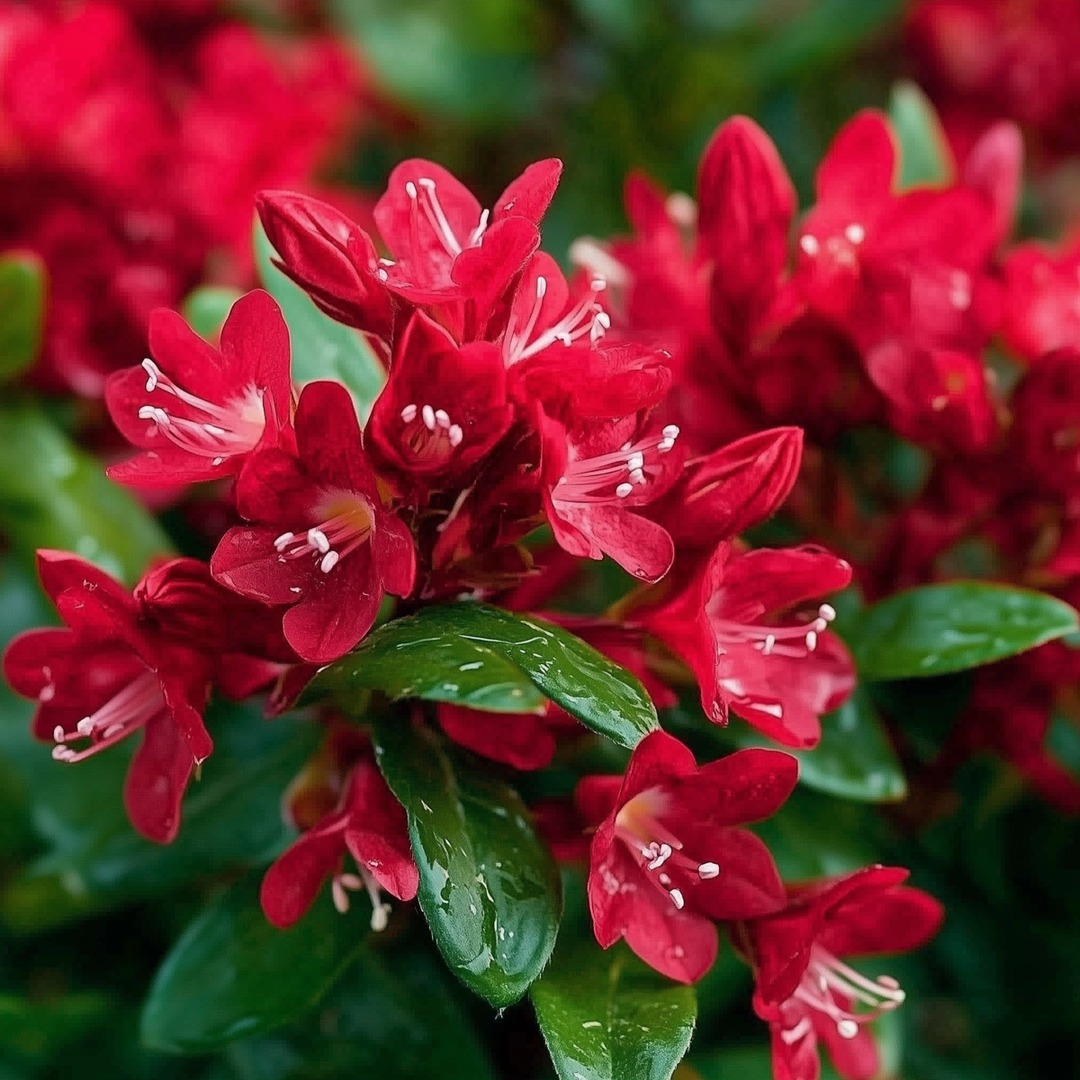
Weigela ‘Red Prince’ is a deciduous shrub admired for its bold, trumpet-shaped red flowers and its easy-going nature. With a mature height and spread of about 4 to 6 feet, this shrub has an upright yet arching habit that adds soft structure to mixed borders or foundation plantings. Its bright green foliage provides a beautiful backdrop for its rich blooms.
Flowering begins in late spring and often continues with sporadic reblooming throughout the summer. The intense crimson-red flowers are highly attractive to hummingbirds and butterflies, making it a valuable plant for pollinator gardens. Even when not in bloom, its neat growth habit and foliage keep it attractive throughout the growing season.
‘Red Prince’ grows well in USDA zones 4 through 8 and prefers full sun for the best flower production, though it can tolerate partial shade. It adapts easily to most well-drained soils and requires little maintenance once established. Prune right after the main flowering period to maintain shape and encourage new growth. This variety is drought-tolerant once mature and resists most common pests.
Red Hibiscus (Hibiscus rosa-sinensis / Hibiscus syriacus)
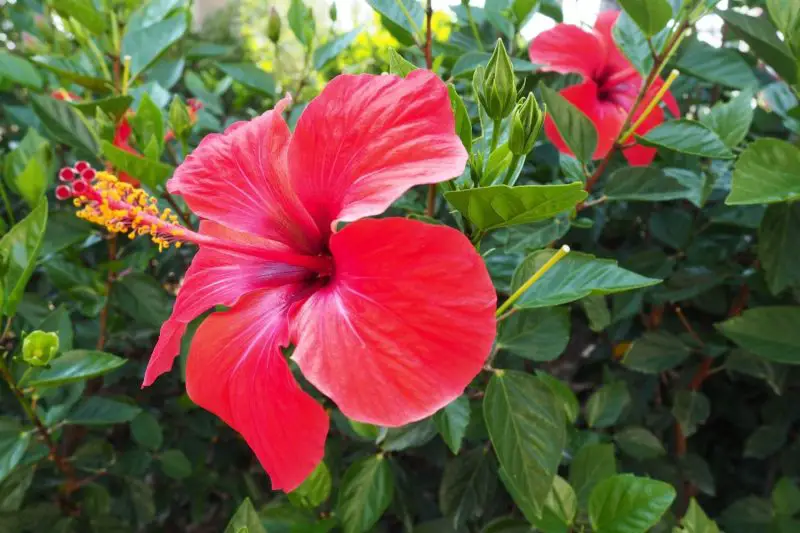
Red hibiscus plants come in both tropical and hardy forms, offering gardeners in various climates a chance to enjoy their vibrant blooms. The tropical Hibiscus rosa-sinensis typically features glossy, dark green leaves and large, showy red flowers, while Hibiscus syriacus, or rose of Sharon, offers more cold-hardy options with slightly smaller, yet equally striking, red-toned blooms. Both types are valued for their ornamental appeal and bold presence.
These hibiscus varieties bloom from summer into fall, producing wide, trumpet-shaped flowers in vivid shades of red. The tropical forms are often used in containers or as hedges in warm climates, whereas hardy hibiscus can be grown in garden beds in cooler regions. The blooms attract bees, butterflies, and hummingbirds, and though each flower lasts only a day, they appear in such rapid succession that the plant seems to bloom continuously.
Tropical hibiscus grows best in USDA zones 9 to 11, while hardy hibiscus thrives in zones 5 to 9, depending on the cultivar. Both prefer full sun and well-draining soil. Keep the soil evenly moist and mulch to conserve water and regulate temperature. Fertilize regularly during the growing season to promote abundant blooms, and prune in early spring to remove deadwood and encourage bushier growth.
Camellia (Camellia japonica – red cultivars)
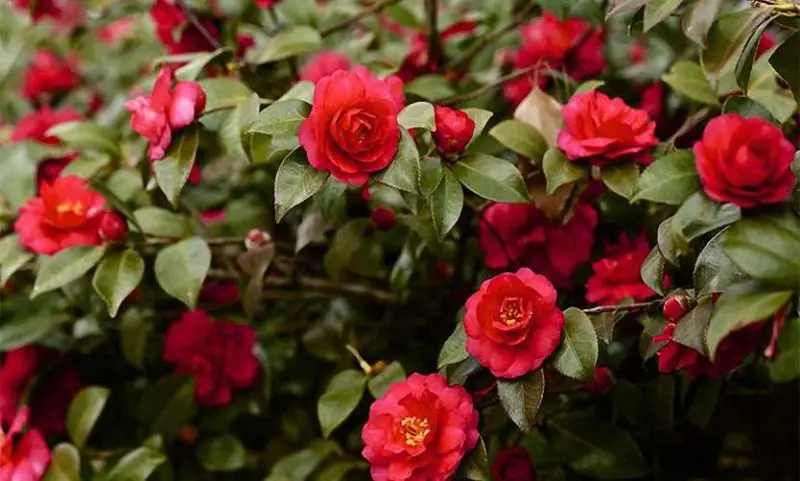
Red-flowering cultivars of Camellia japonica are a timeless choice for gardens seeking elegance and winter-to-spring color. These evergreen shrubs feature glossy, deep green leaves and a stately, upright form, usually reaching 6 to 12 feet tall over time. Camellias are slow-growing but long-lived, often forming a graceful, layered structure with age.
Blooming from late winter into early spring, red camellias produce large, rose-like flowers in various shades of red—from soft crimson to deep scarlet. These blooms often have a formal or semi-double form and can last for several weeks, offering a bold splash of color when most other plants are dormant. Their flowers are also excellent for indoor floral arrangements.
Camellias thrive in USDA zones 7 to 9 and prefer partial shade with protection from harsh afternoon sun. They grow best in acidic, well-draining soil enriched with organic matter. Keep soil consistently moist but not soggy, and mulch regularly to conserve moisture. Pruning is rarely needed but can be done after flowering to shape the plant and remove dead branches. Feed with a fertilizer formulated for acid-loving plants in early spring and midsummer.
Flowering Quince (Chaenomeles speciosa)
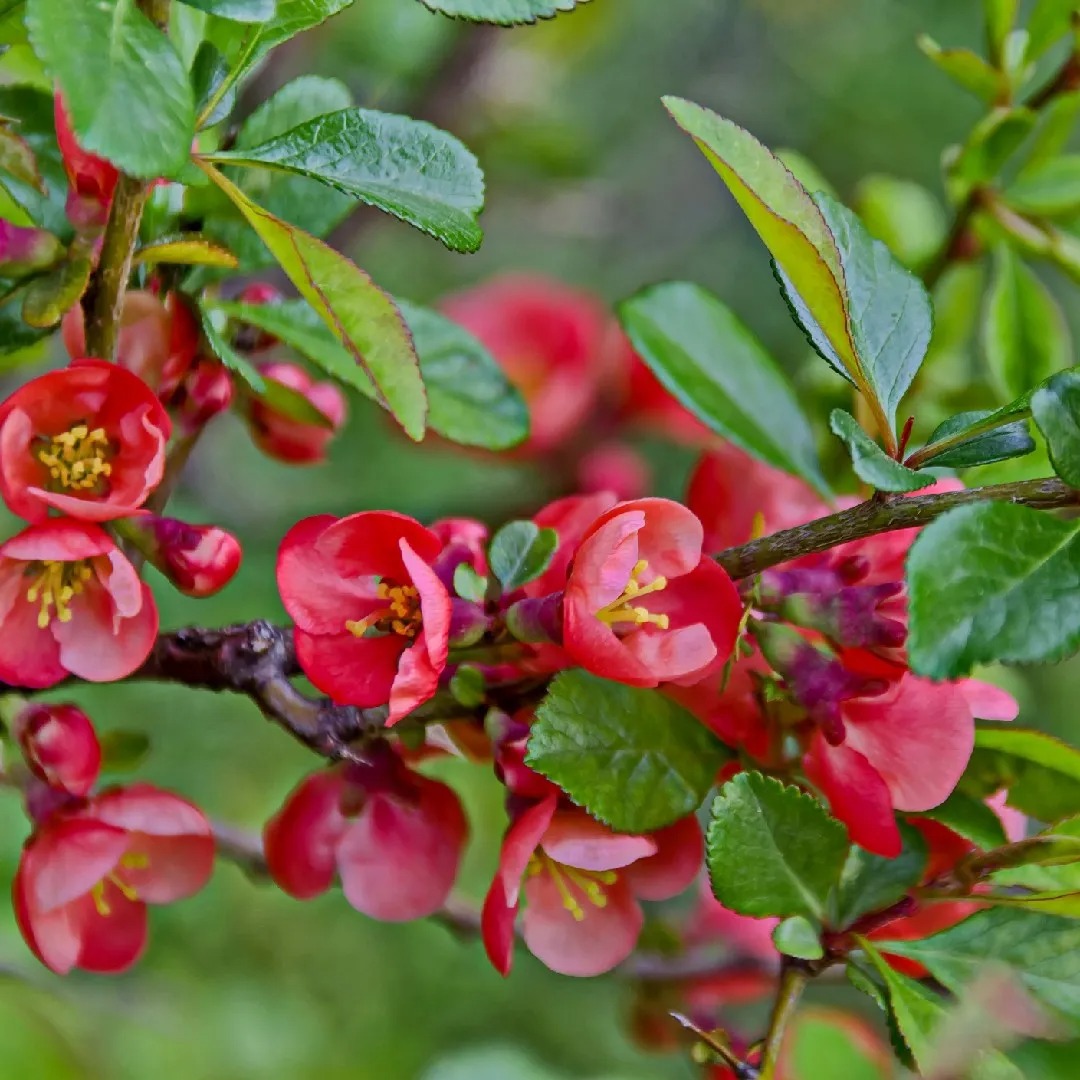
Flowering quince is a dense, multi-stemmed deciduous shrub that bursts into vivid red blossoms in early spring, often before its leaves emerge. It typically grows 3 to 10 feet tall, depending on the cultivar, and features spiny branches, which make it an excellent choice for use as a barrier hedge or foundation planting. The plant’s tangled, upright form gives it a rugged charm even during the dormant season.
The red, cup-shaped flowers appear in profusion from late winter through early spring and may continue blooming sporadically into early summer. The blooms are often followed by small, apple-like yellow fruits that are fragrant and can be used in jellies or preserves. Flowering quince is a favorite among early-season pollinators and adds brilliant color at a time when most gardens are still waking up.
Hardy in USDA zones 5 through 9, flowering quince grows best in full sun to partial shade and well-drained soil. Once established, it is drought-tolerant and low-maintenance. Prune after flowering to shape the shrub and remove dead or overly tangled branches. It benefits from occasional fertilization and mulching but is generally resistant to pests and diseases.
Red-Flowering Currant (Ribes sanguineum)
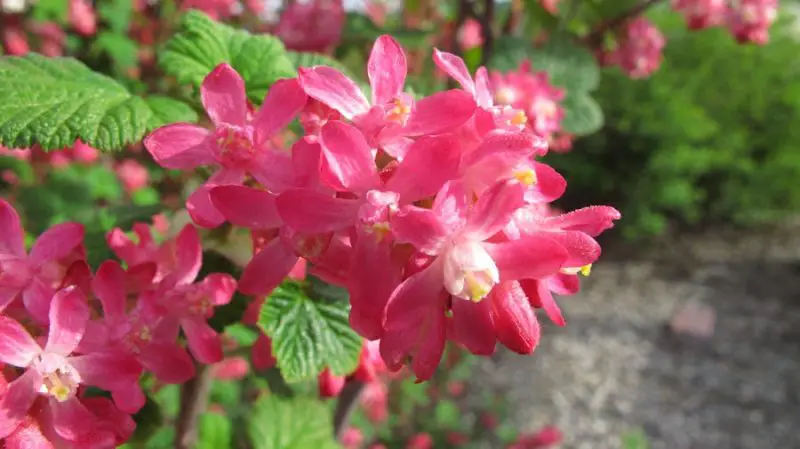
Red-flowering currant is a deciduous shrub native to the Pacific Northwest, prized for its ornamental appeal and ease of cultivation. Typically reaching 6 to 10 feet in height, it has a rounded, upright growth habit and deeply lobed green leaves that emit a pleasant fragrance when brushed. This shrub is particularly valued for naturalistic plantings and woodland gardens.
Its striking red flowers bloom in early to mid-spring in drooping clusters, or racemes, that are both eye-catching and attractive to pollinators. Hummingbirds are especially drawn to the blooms, making this plant a great addition to wildlife gardens. After flowering, small blue-black berries may appear, offering a mild food source for birds.
Red-flowering currant thrives in USDA hardiness zones 6 through 10 and prefers full sun to partial shade. It does well in a variety of soil types, including clay and sandy soils, as long as they are well-drained. The plant is drought-tolerant once established and requires minimal maintenance. Prune after flowering to promote bushiness and encourage future blooms.
Bottlebrush (Callistemon spp.)
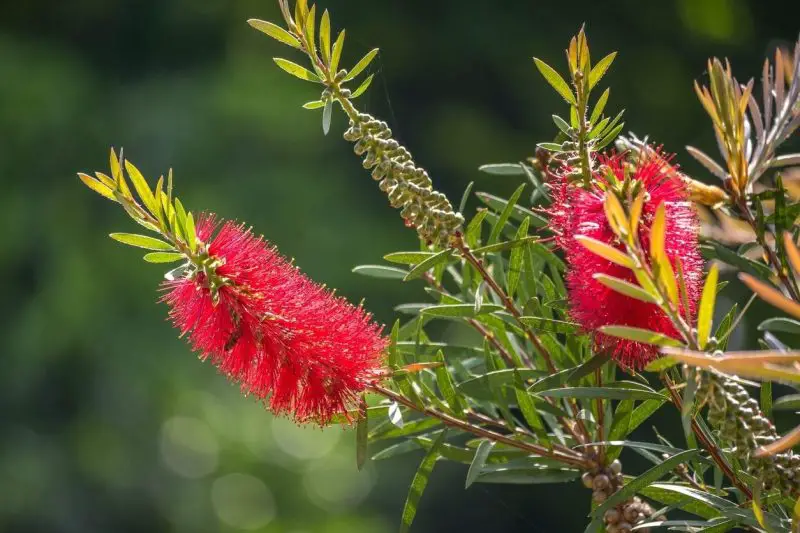
Bottlebrush is a distinctive evergreen shrub native to Australia but widely grown in warm regions such as the southern United States and California. The name comes from its unique, cylindrical flower spikes that resemble old-fashioned bottle-cleaning brushes. This shrub generally grows 4 to 10 feet tall and is favored for its bold appearance and attractive foliage.
The plant blooms from late spring through summer, producing vivid red flower spikes made up of long stamens that create a fuzzy appearance. These dramatic flowers are highly attractive to bees, butterflies, and hummingbirds. In some climates, bottlebrush may flower intermittently throughout the year, especially if conditions remain warm and mild.
Suitable for USDA zones 8 to 11, bottlebrush grows best in full sun and well-drained soil. It tolerates heat, drought, and even some salt, making it an excellent choice for coastal and arid gardens. Light pruning after flowering helps maintain a tidy shape. Mulching and occasional watering during dry periods will keep the plant healthy and blooming.
Texas Ranger (Leucophyllum frutescens – red cultivars)
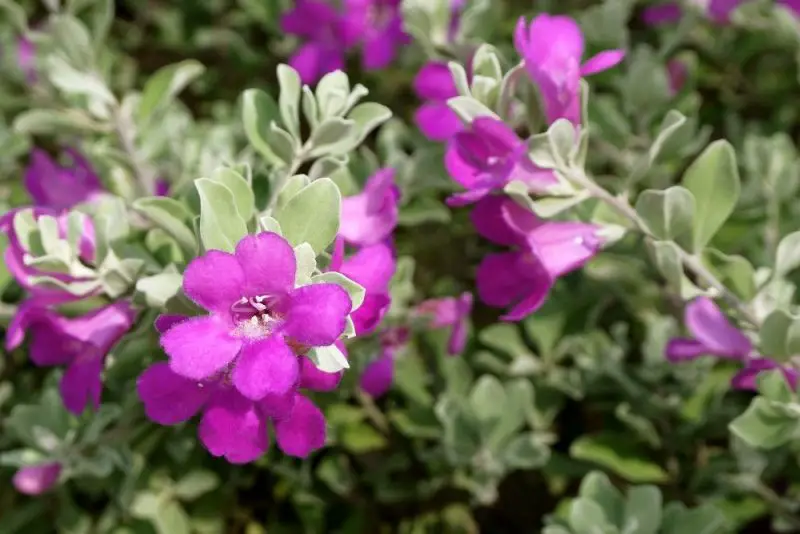
Texas Ranger is a heat- and drought-tolerant shrub native to the arid regions of the southwestern United States. Known for its silvery-gray foliage and bursts of colorful flowers, red-flowering cultivars bring a vibrant touch to xeriscapes and desert-themed landscapes. The shrub typically grows 5 to 8 feet tall with a rounded, bushy habit.
Its tubular flowers bloom intermittently throughout the hot season, especially after summer rains. The blooms range from reddish-purple to magenta, depending on the cultivar, and are highly attractive to pollinators. Unlike many plants, Texas Ranger thrives in extreme heat and even seems to respond to atmospheric humidity changes with sudden flushes of bloom.
Best suited for USDA zones 8 through 11, Texas Ranger requires full sun and thrives in poor, rocky, or sandy soil with excellent drainage. Once established, it needs very little water and should not be over-irrigated. Minimal pruning is needed to maintain shape, and the shrub is virtually pest- and disease-free. It is a top choice for low-maintenance, drought-tolerant landscapes.
Bush Honeysuckle (Lonicera tatarica – red cultivars)
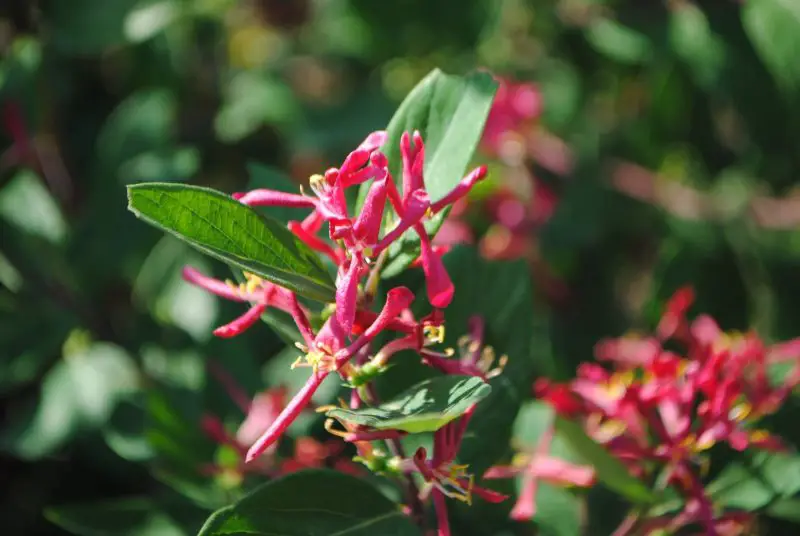
Bush honeysuckle is a deciduous shrub that forms a dense thicket of arching stems covered in oval green leaves. Red-flowered cultivars of Lonicera tatarica are especially popular in parks, suburban landscapes, and informal hedges. These shrubs grow 6 to 10 feet tall and can spread widely if not regularly maintained.
Blooming occurs in late spring to early summer, with small tubular red flowers that appear in pairs along the stems. The flowers are not only ornamental but also a magnet for hummingbirds and other nectar-seeking insects. After flowering, the plant often produces small red berries, which are consumed by birds but considered mildly toxic to humans.
Bush honeysuckle is hardy in USDA zones 3 through 8 and adapts well to a wide range of soil types and conditions. It prefers full sun to partial shade and is remarkably tolerant of urban pollution, drought, and neglect. Pruning can be done after flowering to control its spread and rejuvenate older plants. Though durable, it can be invasive in some areas, so care should be taken when planting near wild spaces.
Pomegranate Shrub (Punica granatum – ornamental)
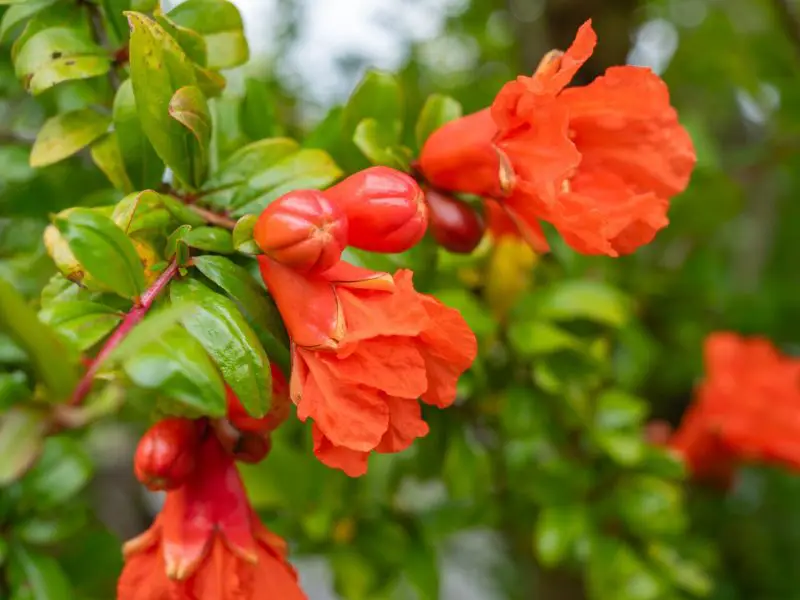
The ornamental pomegranate shrub is a compact, deciduous plant often grown for its fiery red flowers rather than its fruit. It typically reaches 4 to 8 feet tall and has narrow, glossy green leaves that provide a lush background to the dramatic blooms. The plant is particularly popular in California and the arid southwestern regions of the U.S., where it brings Mediterranean flair to the garden.
Blooming begins in late spring and continues through summer, with large, ruffled red flowers appearing at the tips of branches. These blooms are followed by small, inedible fruit in ornamental varieties, though they resemble the edible pomegranate. The bright flowers are attractive to hummingbirds and pollinators, adding vibrancy to warm-climate landscapes.
Hardy in USDA zones 7 through 10, the pomegranate shrub thrives in full sun and well-drained soil. It is drought-tolerant once established and performs best with occasional deep watering. Pruning should be done in late winter to shape the plant and encourage new growth. It adapts well to containers and formal or informal plantings.
Indian Hawthorn (Rhaphiolepis indica – red cultivars)
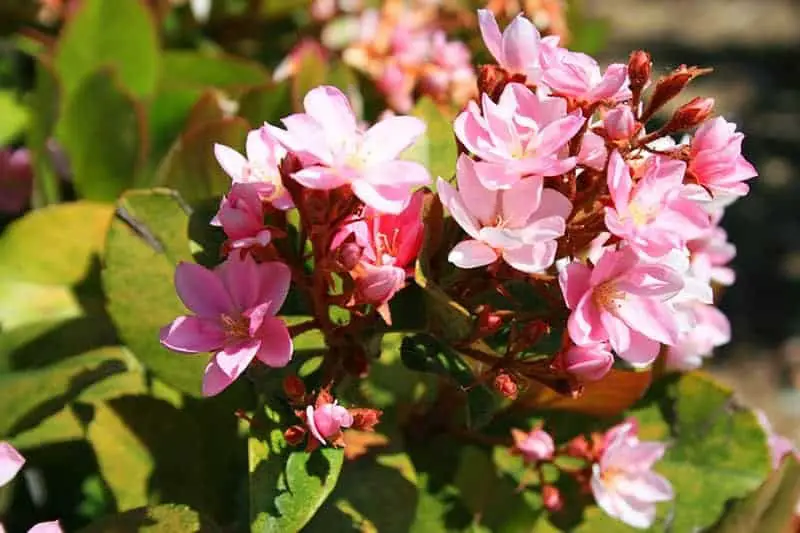
Indian hawthorn is a compact, evergreen shrub widely used in urban and coastal landscaping, thanks to its tolerance of salt, wind, and heat. While traditionally grown with pink or white flowers, newer red-flowering cultivars are gaining popularity for their bold, ornamental impact. The shrub forms a rounded shape, typically 3 to 5 feet in height, with leathery, glossy green leaves.
Red cultivars bloom in spring with clusters of deep pink to red flowers that contrast beautifully against the foliage. The flowers are followed by small, blue-black berries that persist into winter, adding seasonal interest. Indian hawthorn is favored for low-maintenance hedges, borders, and foundation plantings.
Best suited for USDA zones 7 through 10, Indian hawthorn grows well in full sun and moderately fertile, well-drained soil. It is drought-tolerant, disease-resistant, and requires minimal pruning. For best performance, water occasionally during dry spells and apply mulch to retain soil moisture and suppress weeds.
Coral Bean (Erythrina herbacea)
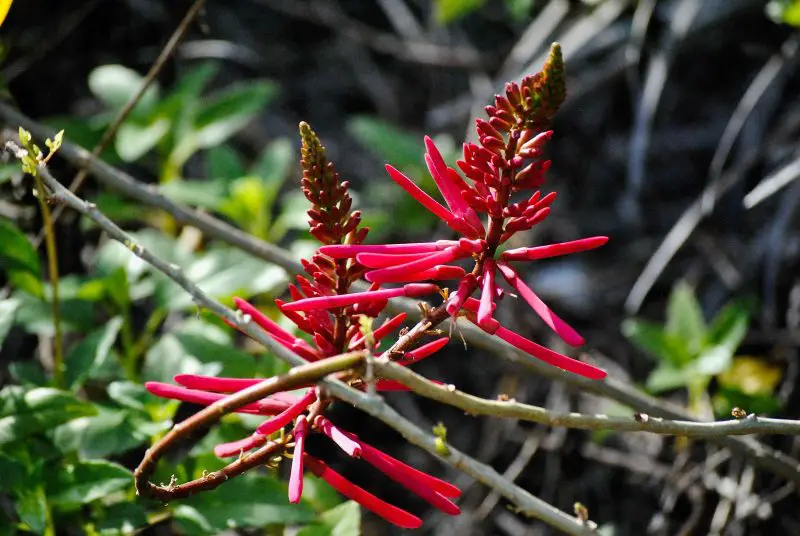
Coral bean is a striking, semi-deciduous shrub native to the southeastern United States, especially admired for its dramatic red tubular flowers. It typically grows between 4 to 6 feet tall but may reach taller heights in warmer climates. The plant features thorny stems and compound leaves, and it is well-adapted to native, wildlife-friendly gardens.
Blooming from late spring through summer, the long spikes of scarlet flowers rise above the foliage and are particularly attractive to hummingbirds and butterflies. These vivid blooms are followed by seed pods containing bright red seeds, which are toxic if ingested. Despite its delicate appearance in bloom, coral bean has a tough, drought-tolerant nature.
Coral bean thrives in USDA zones 7 through 10 and prefers full sun and well-drained soil. It tolerates poor soils and can handle occasional dry conditions. Prune in late winter to remove dead wood and encourage healthy growth. In colder parts of its range, the plant may die back in winter and regrow from the base in spring.
Bougainvillea (Bougainvillea glabra – red cultivars)
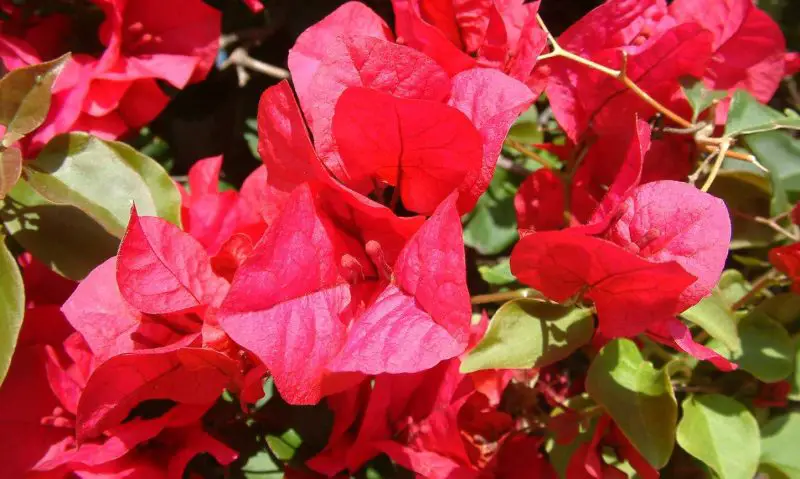
Bougainvillea is a tropical vine often trained and pruned into a shrub-like form for use in landscapes and containers. Known for its papery, brightly colored bracts, red-flowering cultivars create an especially bold statement in warm-climate gardens. The plant has thorny stems and small, dark green leaves, contributing to its dense, tangled growth.
While its true flowers are tiny and white, they are surrounded by vivid red bracts that bloom prolifically from spring through fall. These colorful displays are triggered by dry conditions and full sun, making bougainvillea ideal for drought-prone areas. Red cultivars provide an intense burst of color that brightens walls, fences, and borders.
Hardy in USDA zones 9 through 11, bougainvillea needs full sun and well-drained soil to thrive. It prefers a slightly lean soil mix and sparse watering once established. To maintain a shrub form, prune regularly and support young plants with training structures. Overwatering can reduce flowering, so dry, sunny conditions are best.
Japanese Barberry (Berberis thunbergii – red types)
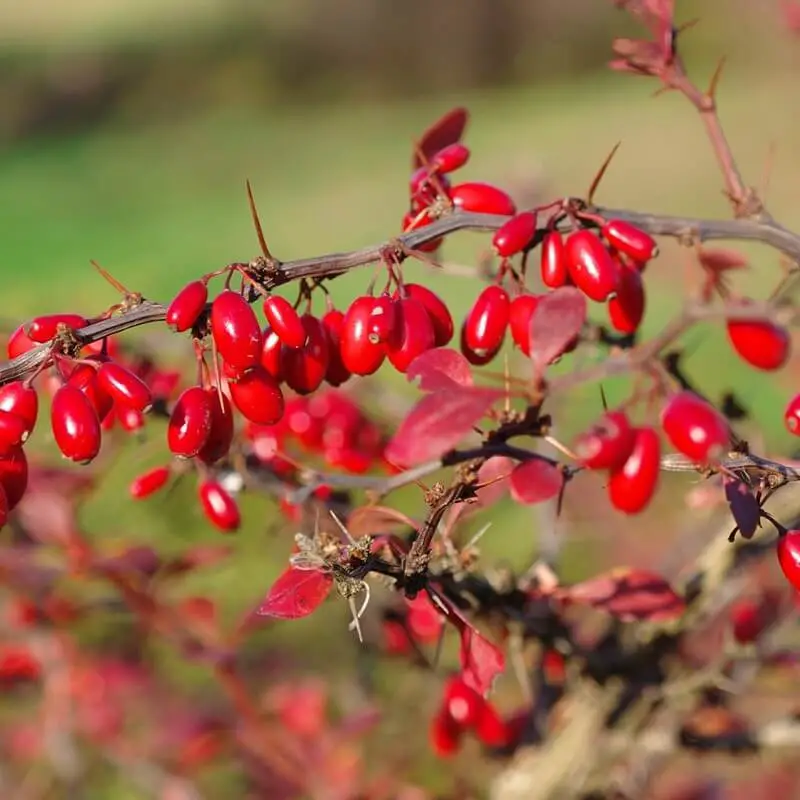
Japanese barberry is a versatile, deciduous shrub known for its colorful foliage and adaptability. Red-leaved cultivars are especially popular for ornamental hedging, borders, and foundation plantings. The plant grows 3 to 6 feet tall and forms a rounded or arching shape, with spiny stems that make it an effective barrier plant.
Though small, the springtime flowers can range from yellow to red in some cultivars, appearing before or alongside the foliage. These blooms are followed by small, bright red berries that persist into winter and attract birds. The vibrant red leaves provide multi-season interest, often deepening in color during fall.
Hardy in USDA zones 4 through 8, Japanese barberry tolerates a wide range of soils and growing conditions. It prefers full sun for best color but will also grow in partial shade. Once established, it is drought-tolerant and requires little care. Prune in late winter to shape and thin the plant, and be aware that it can be invasive in some regions.
Salvia greggii ‘Furman’s Red’ (Autumn Sage)
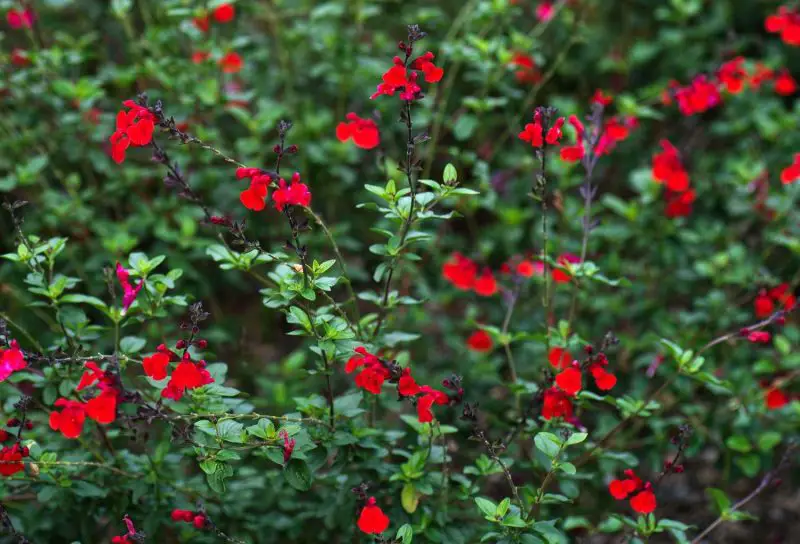
Salvia greggii ‘Furman’s Red’, commonly known as Autumn Sage, is a compact, woody shrub native to Texas and northern Mexico. It is well known for its vibrant red flowers and aromatic, small green leaves. Typically growing 2 to 3 feet tall, this salvia is an excellent choice for borders, xeriscapes, and pollinator gardens in hot climates.
The brilliant tubular red flowers appear from spring through fall, providing long-lasting color and attracting hummingbirds and butterflies. Its extended blooming period and drought tolerance make it highly valued in southwestern U.S. gardens. The plant continues to flower until frost, offering consistent visual interest throughout the warm months.
Autumn Sage thrives in USDA zones 6 through 9 and prefers full sun with well-drained soil. It is drought-tolerant and requires minimal maintenance once established. Occasional pruning after flowering will help maintain its shape and encourage more blooms. Avoid overwatering, as it prefers slightly dry conditions.
Crape Myrtle (Lagerstroemia indica – red varieties)
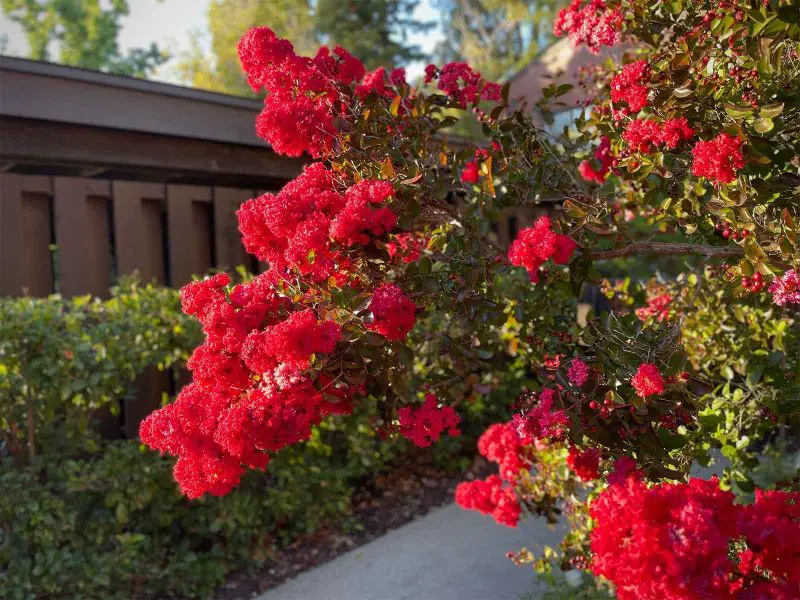
Crape Myrtle is a popular flowering shrub or small tree known for its spectacular summer blooms and attractive bark. Red-flowered varieties such as ‘Dynamite’ or ‘Red Rocket’ are especially favored in Southern landscapes, including Georgia, Texas, and the Carolinas. These plants range in height from 4 to over 20 feet, depending on the cultivar.
Red crape myrtles burst into bloom during midsummer and continue flowering into early fall. The blossoms appear in large clusters and are followed by seed capsules that add winter texture. Its striking red hues stand out in hot, sunny gardens and pair well with other drought-tolerant plants.
Hardy in USDA zones 6 through 9, crape myrtles thrive in full sun and well-drained soil. They tolerate heat, humidity, and even some drought. Prune in late winter or early spring to encourage new growth and shape the plant. Mulching helps retain soil moisture and suppress weeds, though avoid heavy fertilization to prevent excess foliage at the expense of blooms.
Grevillea ‘Red Hooks’
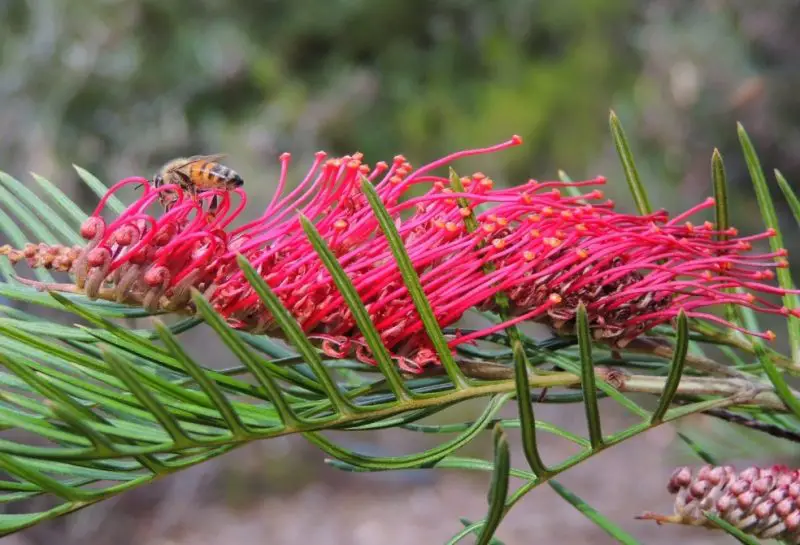
Grevillea ‘Red Hooks’ is a unique evergreen shrub native to Australia, cultivated in parts of California and the coastal South for its unusual, spidery red flowers and fine-textured foliage. It typically reaches 6 to 10 feet in height and has long, fern-like leaves that lend a tropical look to water-wise landscapes.
The plant blooms primarily in late winter and spring, though it may produce scattered flowers year-round in mild climates. The red, curved flowers are highly attractive to nectar-feeding birds and bees. Its distinctive shape and vibrant color add architectural flair to gardens in warm, dry areas.
This shrub grows best in USDA zones 9 through 11 and thrives in full sun and fast-draining soil. Grevillea ‘Red Hooks’ is drought-tolerant and should not be overwatered. It benefits from occasional pruning to keep it dense and attractive. Avoid phosphorus-rich fertilizers, as grevilleas are sensitive to high phosphorus levels.
Fuchsia magellanica
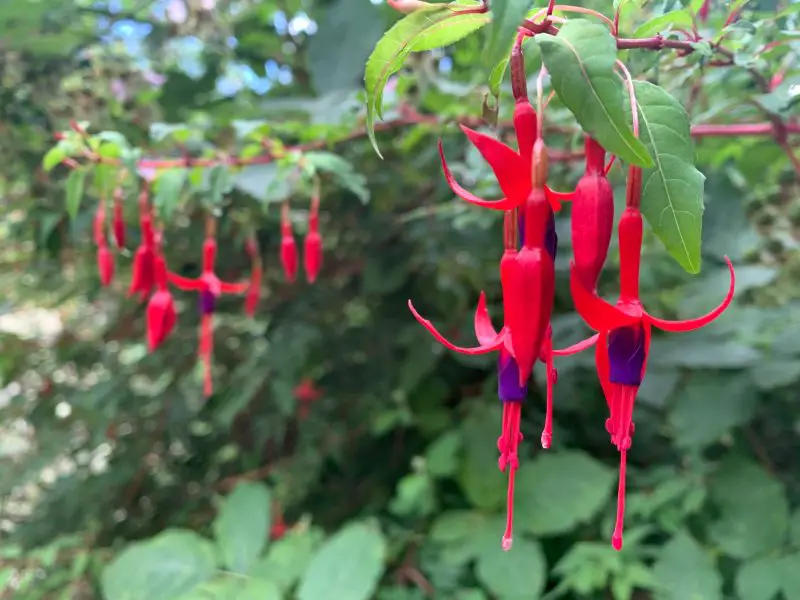
Fuchsia magellanica is a hardy fuchsia shrub valued for its graceful, drooping flowers in shades of red and purple. Native to South America, it has become a favorite in the coastal and temperate gardens of the western United States, particularly in California and the Pacific Northwest. This deciduous shrub grows 3 to 10 feet tall, forming a bushy, arching structure.
Its striking flowers, which resemble small dangling lanterns, appear from late spring into fall. The vivid red sepals and purple corollas are irresistible to hummingbirds and add charm to shaded or partly shaded garden areas. It also offers colorful fall foliage before going dormant in winter.
Fuchsia magellanica performs well in USDA zones 6 through 9 and prefers cool, moist conditions with dappled shade. It requires regular watering and benefits from mulching to retain moisture. Prune in early spring to remove dead stems and promote bushy growth. Protection from harsh winter winds is recommended in colder regions.
Red Campsis (Campsis radicans – red cultivars)
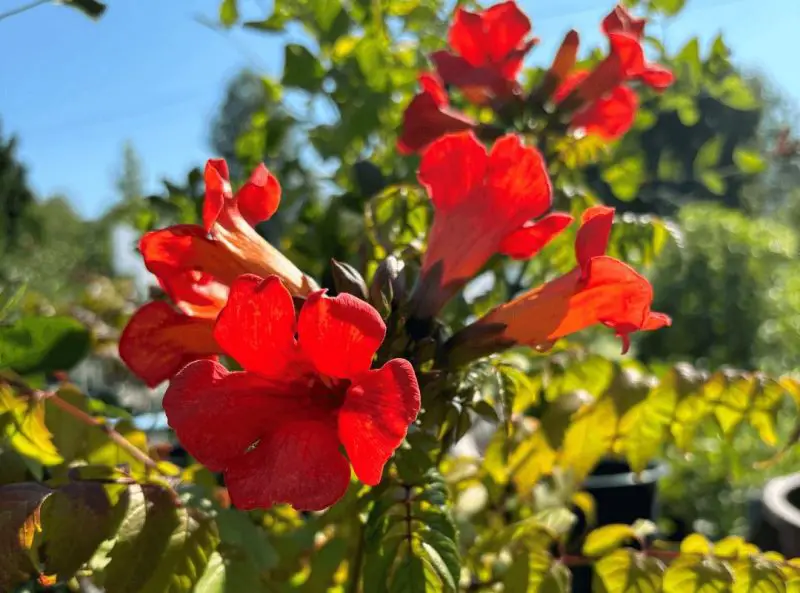
Red Campsis, also known as trumpet vine, is a vigorous plant that, while typically grown as a climber, can be pruned and shaped into a sprawling, shrub-like form. Red cultivars display brilliant red-orange, trumpet-shaped flowers that bloom in large clusters, adding a fiery splash of color to gardens during the heat of summer. It is a bold choice for naturalistic or cottage-style landscapes.
Flowering occurs from mid to late summer, often extending into early fall. The vivid flowers attract hummingbirds and other pollinators, while the plant’s fast-growing habit allows it to quickly fill in empty spaces. Despite its tropical appearance, it is surprisingly hardy and long-lived.
This plant thrives in USDA zones 4 through 9 and prefers full sun for best blooming. It tolerates a range of soil types but performs best in well-drained, moderately fertile soil. Once established, it is drought-tolerant and low-maintenance, though regular pruning is essential to manage its vigorous growth and shape it as a shrub.
Russelia equisetiformis (Firecracker Plant)
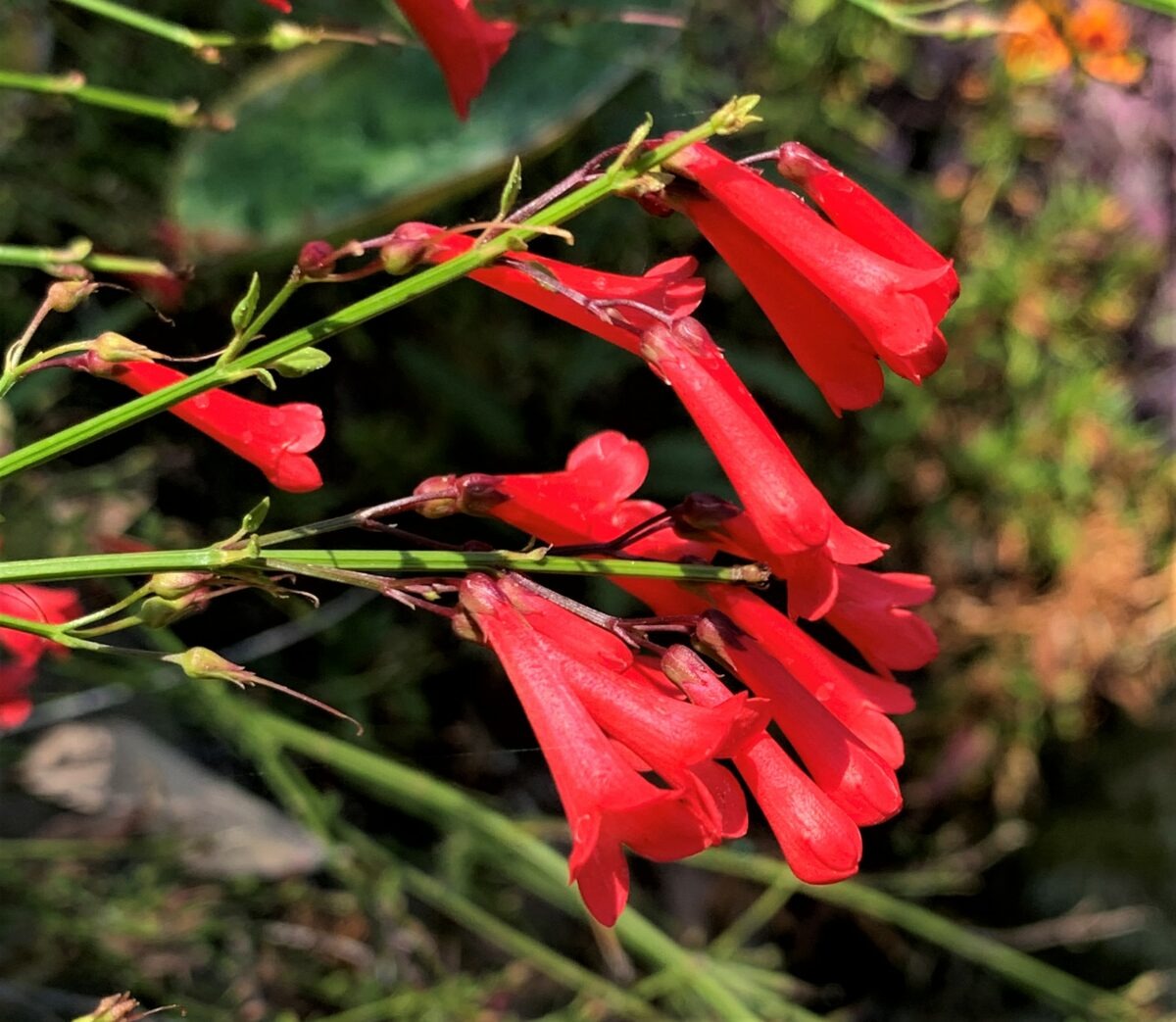
Russelia equisetiformis, commonly known as the Firecracker Plant, is a heat-loving, fountain-shaped shrub admired for its graceful arching stems and abundance of tubular red flowers. Native to Mexico, this compact shrub grows 2 to 4 feet tall and wide, making it an ideal choice for tropical-style gardens or containers.
Its flowers resemble miniature firecrackers and bloom profusely from spring through fall, often continuing year-round in frost-free areas. The plant’s cascading habit and vibrant color make it a standout in borders, rock gardens, or hanging baskets. Hummingbirds are especially attracted to its nectar-rich blooms.
Best grown in USDA zones 9 through 11, the Firecracker Plant prefers full sun to partial shade and thrives in well-drained soil. It is moderately drought-tolerant once established and benefits from occasional trimming to encourage dense growth. In cooler climates, it can be overwintered indoors or grown as an annual.
Calliandra haematocephala (Powder Puff Shrub)
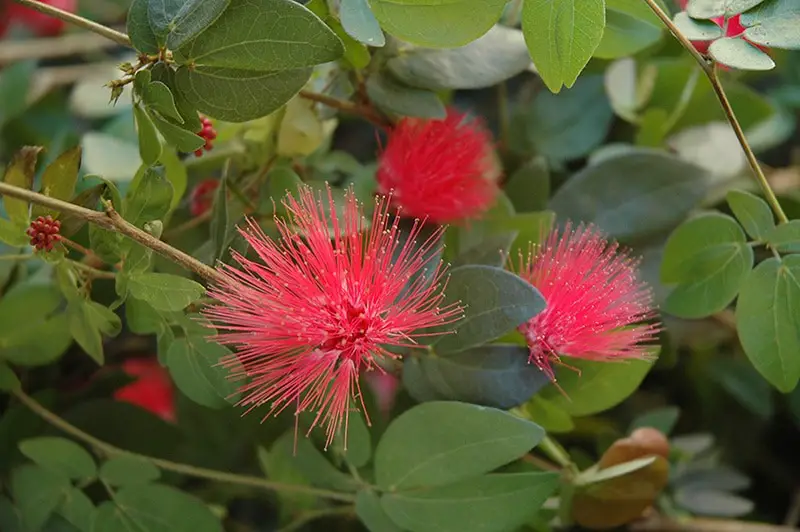
Calliandra haematocephala, known as the Powder Puff Shrub, is a tropical evergreen with exotic, red, fluffy ball-like flowers that resemble powder puffs. This eye-catching shrub typically grows 6 to 15 feet tall and is native to Bolivia. It is a favorite in warm-climate gardens for its whimsical flowers and fern-like foliage.
The bright red blossoms appear mainly from fall through spring, adding bursts of vibrant color during cooler months. The long, threadlike stamens give the flower heads a delicate, feathery appearance. This plant is highly attractive to bees, butterflies, and hummingbirds.
Well-suited for USDA zones 9 through 11, the Powder Puff Shrub thrives in full sun to partial shade and prefers moist, well-drained soil. It benefits from regular watering during dry spells and light pruning to maintain shape. Though tropical in nature, it can be grown in large containers and moved indoors in colder regions.


